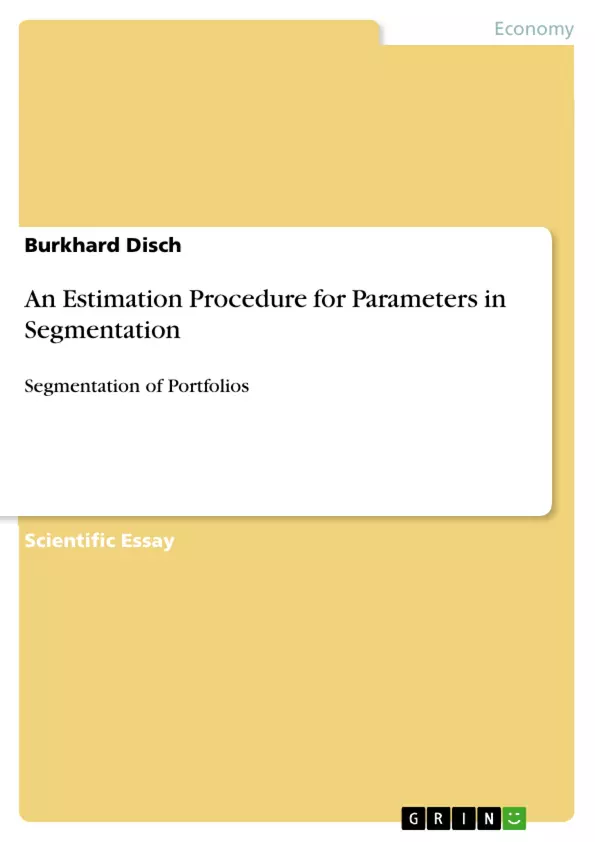In practice, the actuarial valuation of a stock or an available inventory for new business target market segmentation plays a prominent role, so the formation of sub-stocks to sociological, demographic, geographic or other to be deemed as a corporate-policy relevant criteria. The main problem is to answer the question how great the stock shares for the respective segments are and what the ratios between the termination probabilities are. While estimating the termi-nation probabilities is relatively simple and - with restrictions - can be reliably estimated from external statistics, the stock distribution is highly dependent on the individual company's situ-ation.
What is often known, however, is the affiliation to one segment in the case of termination, when a questionnaire, a special test or a medical examination can be carried out. If there are enough termination cases verifiable, we show that a detailed knowledge of the segmentation of the portfolio to determine the number of terminations is not necessary. The actuarial ap-proach to this is the fact that at any given time and portfolio with a number of termination cases, only the distribution of the number of termination cases in the segments is necessary to determine the individual component units, not the exact number of risks within the (sub-) segments. To calculate this, we determine a division of a given stock portfolio, as we estimate the parameters of segmentation - and calculate the portfolio shares in respect of such subdivi-sion.
The parameters solves some best approximation-criteria. We show this criteria and give the solution of the approximationproblem in some special cases with examples for application. We do this in the deterministic and the stochastic case. We calculate the volume of payments in the different segments by applicating the parameters.
Inhaltsverzeichnis (Table of Contents)
- Introduction
- Parameter estimation methods
- Differentiated tariffs Smoking / Non-smoking
Zielsetzung und Themenschwerpunkte (Objectives and Key Themes)
This paper aims to develop an estimation procedure for parameters in market segmentation, specifically within the context of actuarial valuation of life insurance stocks. The procedure aims to address the challenge of determining stock shares for different segments and the ratios between termination probabilities, when direct information about stock distribution is limited.
- Market segmentation in actuarial valuation
- Estimation of stock shares and termination probabilities
- Approximation methods for determining segmentation parameters
- Application to differentiated tariffs (e.g., smoker/non-smoker)
- Stochastic analysis of segmentation parameters
Zusammenfassung der Kapitel (Chapter Summaries)
- Introduction: The paper introduces the problem of determining stock shares and termination probabilities for different market segments in actuarial valuation. It highlights the importance of this problem, particularly in the context of Solvency models and risk assessment. The challenges associated with limited knowledge of stock distribution are discussed, and the need for an estimation procedure based on available data is presented.
- Parameter estimation methods: The paper outlines the basic estimation procedure, introducing the parameters (ai) and their role in representing the segmentation of the stock portfolio. It emphasizes the importance of finding parameters that minimize the error-squares between observed data and estimated values. The paper also introduces the concept of normalized stock shares and the optimization problem (*), which aims to determine the parameters by minimizing a specific function.
- Differentiated tariffs Smoking / Non-smoking: This section presents a special case of the estimation problem, where the segmentation involves only two segments (e.g., smoker/non-smoker). The solution is derived explicitly, and an example is provided to demonstrate the application of the procedure. The impact of different termination probability ratios (s) on the estimated stock distribution is analyzed.
Schlüsselwörter (Keywords)
This paper focuses on the keywords segmentation, actuarial valuation, life insurance stocks, termination probabilities, and parameter estimation. The main themes include the application of statistical methods for determining stock distribution and termination rates within different segments. The paper also explores the concept of approximation and optimization, as well as the use of stochastic analysis for assessing the uncertainty in segmentation parameters. Key examples include smoker/non-smoker tariffs and the impact of various segmentation criteria on risk assessment and actuarial valuation.
- Quote paper
- Dr. Burkhard Disch (Author), 2009, An Estimation Procedure for Parameters in Segmentation, Munich, GRIN Verlag, https://www.grin.com/document/151554



